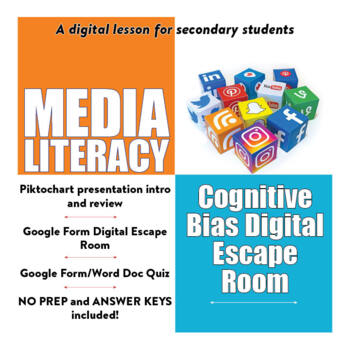Media Literacy: Cognitive Bias Digital Escape Room
- Word Document File
- Google Apps™
- Internet Activities

What educators are saying
Also included in
- This multi-day bundle can be used as a stand alone 1-2 week unit, as an introduction to academic research in any subject, or during a research unit to review or practice skills. It consists of three individual lessons on cognitive biases, fact vs. opinion, and evaluating sources for credibility. AlPrice $11.60Original Price $14.50Save $2.90
Description
This lesson includes everything you need to introduce high school students to some basic cognitive biases in an engaging way. It is designed to take one class period and can be done individually or in small groups, asynchronously or synchronously in small group breakout rooms. It is meant as an introduction only and focuses on six cognitive biases that students may be prone to when completing critical thinking tasks during learning activities, especially ones that involve research and/or supporting claims. The biases covered in this activity include blind-spot bias, confirmation bias, anchoring, the dunning-kruger effect, the availability heuristic, and in-group bias. Because you will be opening a copy of the Google Form escape room and the Google Form quiz, both are completely editable to fit your needs.
This NO-PREP lesson includes:
1. A digital “escape room” Google form.
2. An introductory Piktochart presentation link embedded in the Google Form.
3. A link to the website yourbias.is embedded in the Google Form for students to use as they work through the escape room.
4. Five escape room tasks and locks covering five different cognitive biases. (The blind-spot bias is covered in the introductory Piktochart.) Each task and lock asks students to answer a few questions that are designed to trigger one of the cognitive biases and then to use the website to determine which cognitive bias was triggered. The answer to this is the “key” to the “lock.”
5. A review Piktochart presentation link embedded in the Google Form.
6. An “exit ticket” reflective question embedded in the Google Form.
7. A short 10-question quiz in hard copy or in digital form with the answer key included.
8. A list of additional readings with links that you can assign as a follow up or as an extension of the lesson for older or more advanced students and a suggested extension group activity.
9. All answer keys included, either in hard copy or embedded in the Google Form.
The lesson is appropriate for all high school students, but may be more challenging for ninth and tenth graders.





